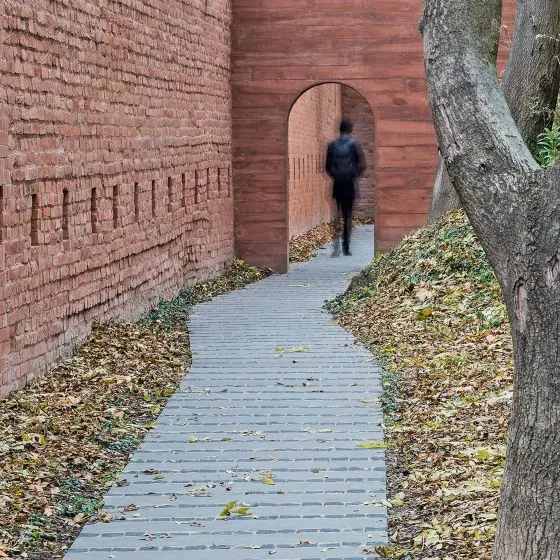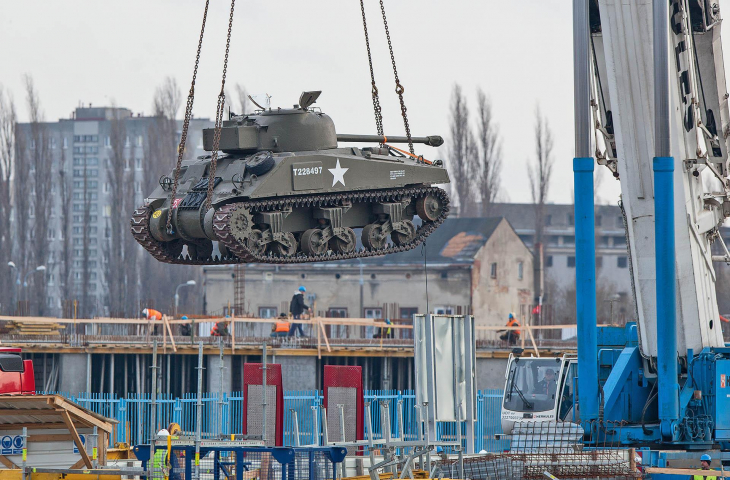From the archives of A&B - the best Polish projects of the last decade
[A&B 05'2017 original material]
The World War II Museum is attracting huge interest from Gdansk residents and tourists. Since the first days, attendance has exceeded bold expectations. This is thanks to its creators: historians and architects, but not only. Unfortunately, the political turmoil unleashed around the building has largely contributed to its media popularity. Architect Jacek Droszcz talks about the project and its fate in an interview with Marta Kulawik.
situation
© Studio Architektoniczne KWADRAT Jacek Droszcz
Marta Kulawik: The Kwadrat design studio has been trying its hand at architectural competitions since its inception. Was it easier to enter them with youthful enthusiasm, during the period of systemic transformation in Poland, or now, with the baggage of experience?
Jacek Droszcz: Architectural competitions, from the beginning of the studio's existence, were the main source of obtaining our orders. Especially the most spectacular ones, so I always took the work on them very seriously. I tried to fit within the specific conditions of the competition. I learned this from my masters Jerzy Kaczorowski, Andrzej Kohnke and Basil Domsta, with whom I still work today. The competition has always been and still is an emotional event in the studio. It is also a team effort, during which ideas presented by two, and at the moment even three, generations of architects working here clash. Looking back from the perspective of twenty years of working on competitions, I can certainly say that neither I nor my partners have ever lacked youthful enthusiasm, and the baggage of experience may be a bit of a nuisance, but in the end it helps to find the right solution.
southwest elevation
pic: © Studio Architektoniczne KWADRAT Jacek Droszcz
Marta: Successive successful competitions have helped to establish the office's position, mainly in the Tri-City. A new icon of Gdansk - the Museum of World War II of your design - was recently put into operation. Does the huge interest in the exhibition, as well as in the building itself, go hand in hand with the satisfaction of the authors?
Jacek: I realize that this tremendous interest in the World War II Museum comes mainly from the political turmoil surrounding the museum as an institution and the exhibition itself. On this occasion, the object and its form are also being discovered. Here I can state with satisfaction that the justified admiration for the exhibition is also accompanied by very positive assessments regarding the architecture of the building.
A fragment of the facade and a conceptual sketch
Photo: Roman Jocher © Museum of World War II; drawing: © Studio Architektoniczne KWADRAT Jacek Droszcz
Marta: Gdansk is an important city for every Pole, and recently its historical role has been emphasized by newly created modern buildings, such as the European Solidarity Center and precisely the World War II Museum. Was it history that was the starting point for developing the competition concept for this museum?
Jacek: It is safe to say that it was history that shaped this building. It is a historical museum, the essence of which is an exhibition dedicated to World War II, but not only! The narrative contained here begins with the history of the birth of totalitarianism after World War I, and ends with images of contemporary events. Thus, the World War II Museum and the European Solidarity Center perfectly complement each other and make the city of Gdansk - a witness of these events - can quickly become an attractive "City of Historical Memory" for tourists.
conceptual sketch
pic: © Studio Architektoniczne KWADRAT Jacek Droszcz
Marta: Your studio defeated almost 130 competitors from around the world, winning the recognition of the jury, including Daniel Libeskind, among others. However, due to the destruction of several coded envelopes before the competition was decided (including the winning entry), voices doubting the principle of anonymity were heard. Did these doubts overshadow the joy of winning?
Jacek: It was a surprising situation, of which the contest participants were informed even before the results were announced. It was a stroke of luck that among those several envelopes were two envelopes of the winning teams, including ours. This was a fatal mistake on the part of the organizers, but after all, it did not affect the jury's verdict. One of the Krakow studios, which did not appear as anything special in the competition, decided to give the case a legal run - and that was sad.
cross sections
pic: © Studio Architektoniczne KWADRAT Jacek Droszcz
Marta: When the emotions subsided, it was time to start working on the detailed design. Between the competition visualizations and the final result, there is practically no difference. Weren't you tempted to change something?
Jacek: As we proceeded to the next phases of the project, it turned out that everything fit here, despite the fact that the competition design was developed with quite a lot of generality. Some functional solutions were changed to a small extent, but the massing remained intact. However, we worked for a long time on the structure of the facade. After some thought, we decided to change its texture. We replaced the previously proposed concrete spray with prefabricated fiber-reinforced concrete panels. This technology allowed us to maintain full control over the final visual effect of the facade.
Making walls with a steep slope turned out to be a challenging task
Photo: Roman Jocher © Museum of World War II
Marta: You call for respect for context and at the same time complain about the lack of expressive contemporary architecture in Poland. The World War II Museum in Gdansk is undoubtedly striking, but is it in any way connected to the fabric of the city?
Jacek: The architectural solutions we propose always result from a desire to properly fit into the context of the place. Hence, they often take on such a variety of stylistic features, not attributable to a single trend. In this case, the choice of concept was determined by many factors. The most important were precisely the location of the building and its role in the structure of the city. The neighborhood of the Main City and the Old City, the close edge of the Radunia and Motława canal and the Young City developing nearby on the post-shipyard areas obliged us to pay special attention. We began looking for solutions that could make the facility not just another museum, but above all a strong spatial marker in the hitherto peripheral district of Gdansk. It was to take on the role of a keystone between the old and the new. Hence the idea to create a vast square where people could meet and relax, not necessarily those interested in visiting the museum, but also those strolling along Dluga Pobrzeze. This explains the idea of placing the main part of the building underground and leaving room for the creation of a sculptural form that would clearly mark the place. This intended strong spatial accent is to lead a kind of dialogue with the historic towers of Gdansk's churches and town halls, inscribing itself in the silhouette of the city with a contemporary form.
plan of level -2
drawing: © Studio Architektoniczne KWADRAT Jacek Droszcz
Marta: This project took more than 4 years to complete, and the planned completion date was postponed several times. What were the reasons for this?
Jacek: One reason was the aforementioned protest after the announcement of the competition results. It took the organizers more than six months to explain the situation. Another several months of postponement was due to works carried out by the city. These were related to the implementation of a strategic sanitary sewer in the immediate vicinity. The final deadline was also affected by the flood that hit Gdansk last year.
A faithfully recreated pre-war street and piles of rubble imitate the image of wartime destruction; the museum has been visited by crowds of visitors since its opening
Photo: Roman Jocher © Museum of World War II
Marta: The World War II Museum is currently undergoing a different kind of wrangling. How do you feel about the issue of merging it with the Westerplatte and 1939 War Museum?
Jacek: I hope that these are indeed just wrangles and everything will return to its place. I was saddened to see how, in a senseless way, politics extinguishes the enthusiasm of the museum's creators and tries to deprive them of the honor they deserve. But whatever happens the World War II Museum is a success story for all those who dedicated the last few years to it.
Marta: Thank you for the interview.



























































































